Cybersecurity Risk Management. Today, we read alarming news about cybersecurity problems.
And as if the pandemic is not enough, cybercrimes are a global concern, too. Reports also show that it increased up to 600% because of the COVID-19 pandemic.
For example, 500,000 Zoom passwords were stolen. Hackers even sold it in dark web crime forums.
Unfortunately, these attacks can result in financial losses. The cost for public companies is much greater.
On average, it can lead up to $116 million. Worse, most organizations do not have a Cybersecurity Risk Management plan.
Cybercrime might become the greatest threat to us in the next five years. Our best defense? Stay informed.
For companies, making cybersecurity systems is a must. But how? One part is a cybersecurity management plan.
But, what is it?
What Is Cybersecurity Risk Management?
Cybersecurity risk management is about planning steps of how you can be secure. So, you’ll have to learn about your information assets and the risks.
For cybersecurity, we don’t rely on locks or vaults. Why? Because we are not dealing with physical files here.
Instead, we depend on technologies. Things like anti-virus apps, encryption, and a firewall. It also includes combinations of strategies against cybercrimes.
But, why is it really important?
Why Is Cybersecurity Risk Management Important?
As mentioned, we want to protect ourselves from cyberattacks. And cybersecurity risk management does that.
With this, you can also obey laws. So, you will not pay fines. But, it involves more than that.
It also doesn’t only protect data. It also gives awareness to your partners and employees.
And in a nutshell, it results in the following:
- lessen cyberattacks and risks
- reduce operational costs
- protect business assets
- increased business reputation
So, how can you make one?
Guide to a Rewarding Cybersecurity Risk Management Plan
In this article, we will talk about a checklist to make a cybersecurity risk management plan.
Understand the organization’s security situation
First, you should know about your current security situation. Do you have controls? Or you don’t even have the most basic apps?
This will help you make a quick response. Especially when cyberattacks happen. So, you can lessen the damages.
Identify the gaps and weaknesses
Next, know about your security weaknesses and gaps. But why?
Prevention is a cure, they say. With you knowing about this is definitely better. Rather than dismissing but regretting later on.
This step will also help you check your risks. Plus, you can prioritize which risks need immediate action.
Assign security responsibilities
In a secure culture, everyone has a share. So, from the highest employee to the lowest should know.
Of course, the IT team isn’t the only person who should maintain security. And that leads us to our next step.
Implement cyber awareness
True, everyone should practice cybersecurity. But, how can they do so if they don’t know how to?
Having cybersecurity awareness training helps. So, they can apply what they have to as an individual.
For example, employees can learn about good password habits. Or even knowing the danger of clicking a suspicious attachment.
After all, employees are the weakest link of security. And just a single click can bring crippling results.

